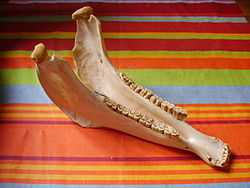Jawbone (instrument)
|
Quijada: a jawbone used as a musical instrument | |
| Percussion instrument | |
|---|---|
| Other names | Quijada de Burro, Charrasga, Jawbone |
| Classification | idiophone |
| Hornbostel–Sachs classification |
112.211 (indirectly struck idiophone; scraped sticks without a resonator) |
| Related instruments | |
| Güiro, güira, reco-reco | |
The quijada [charrasga, or jawbone in English] is a traditional Latin percussion instrument that is cleaned of tissue and dried so the teeth can loosen and act as a rattle. They are traditionally made from the jawbone of either a mule, horse, or donkey.[1] To play, a musician holds one half in one hand and strikes the other with either a stick or their hand; this causes the teeth to rattle against the bone creating a loud, untuned sound, original to this instrument.[2] It is used in music throughout most of Latin America, including Mexico, Peru, El Salvador, Ecuador, and Cuba.[2]
Historical and cultural content
While it is used in most Latin American countries, the quijada gets it origin from the Africans that were brought to the Americas during the colonial era.[2] It is also believed that it was first introduced in Peru, making it an Afro-Peruvian instrument.[3] It is used in traditional and contemporary Latin music; an example is a song being played in Oaxaca, Mexico, using the Quijada to keep the beat for the "cancion". The quijada de burro is most commonly used at carnivals and religious festivals.[4] This instrument is one example of a mix of two different cultures, African and Indigenous, that created an instrument that gained value for the people of Latin America.
See also
References
- ↑ "Jawbone". Virginia Tech Multimedia Music Dictionary. Retrieved 2013-09-15.
- ↑ 2.0 2.1 2.2 Scruggs, TM (2007). "El Salvador". Grove Music Online. Oxford University Press. Retrieved 2013-09-15.
- ↑ Ma, Eve. "A Guide To Afro-Peruvian Musical Instruments". Sounds and Colours. Retrieved 2013-09-16.
- ↑ "Quijada de Burro". Retrieved 23 September 2013.
Further reading
- Beck, John (1994). Encyclopedia of Percussion. Garland. ISBN 978-0-8240-4788-7.
